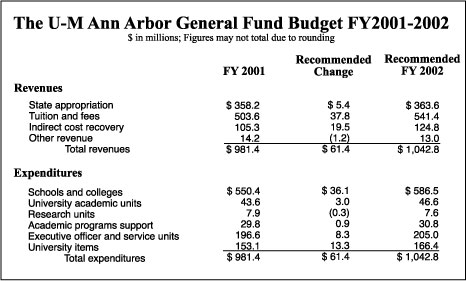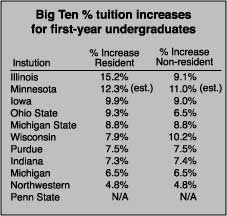By Julie Peterson
Office of the Vice President for Communications

The 2001–02 budget approved by the Board of Regents July 19 is “designed to sustain the quality of the University, consolidate the gains of the past few years and maintain momentum on our most important initiatives,” says President Lee C. Bollinger.
The state appropriation to the University will increase just 1.5 percent for the coming year. Provost Nancy Cantor notes that there has been a direct relationship over the years between state funding and tuition increases.
The proposed tuition increase for most students is 6.5 percent. That figure is among the lowest in the Big Ten and among public institutions in Michigan, continuing a four–year trend, says Paul N. Courant, associate provost for academic and budgetary affairs.
“We have worked hard to restrain our tuition increase despite the difficult state funding environment and rapidly rising costs in areas such as utilities, employee benefits and information technology,” Courant says. “Other institutions in the state and the region are facing much the same pressures we are, and in general, they are responding by increasing tuition rates quite sharply for the coming year.”
Natural gas prices have more than doubled in the past year. The University’s central power plant runs on natural gas. In fiscal 2001, the University spent $13.7 million more than budgeted for natural gas. Reflecting recent reductions in natural gas prices, the budget for fiscal 2002 includes an $8.4 million increase.
Other unavoidable cost increases include an additional $7 million in faculty and staff benefits—driven primarily by the increasing cost of medical care and prescription drugs—and the cost of operating the University’s administrative information systems. The new financial, student administration and human resource information systems had been funded as a series of one-time costs in each of the past five years but now will be supported by an annual general fund allocation.
The budget continues to support commitments in four broad areas of priority: the Life Sciences Initiative; the undergraduate student experience; the information revolution; and maintaining excellence in research, scholarship and teaching through the recruitment and retention of top faculty. The first three areas have been the subjects of special commissions appointed by Bollinger.
Courant listed some of the initiatives and accomplishments that fall under these major priorities as follows:

Faculty retention continues to present a challenge, Courant says. Although faculty salaries have been improved in the past few years, he says, “we continue to face severe competitive pressure on the wages and working environments of faculty.”
Faculty salaries nationwide rose 5.3 percent last year, with salaries at the top universities increasing even more sharply. “At U-M, faculty salaries rose by an average of 5.1 percent during fiscal 2001, implying that we are not quite keeping up with the competition,” Courant says. In the sciences, he notes, there also is competition for improved laboratory and research equipment, and facilities for faculty.
The overall budget projects growth in the general fund of about 6.3 percent, or $61.4 million. The general fund is composed of state appropriations, tuition revenues and indirect cost recovery from sponsored research. Indirect cost recovery is expected to grow by more than $19 million (18.5 percent), reflecting record levels of U-M research activity and associated costs.
When basic budget commitments are factored in for such items as the instructional costs of increased enrollment, increases in financial aid,
increased research activity levels, utility and employee benefit cost increases, the resulting amount is $20 million less than is needed to offer minimally competitive salary increases for faculty and staff, and to meet other essential commitments, Courant said. The difference is made up by cost savings and budget reallocations.
Examples of cost savings in the proposed budget include:

